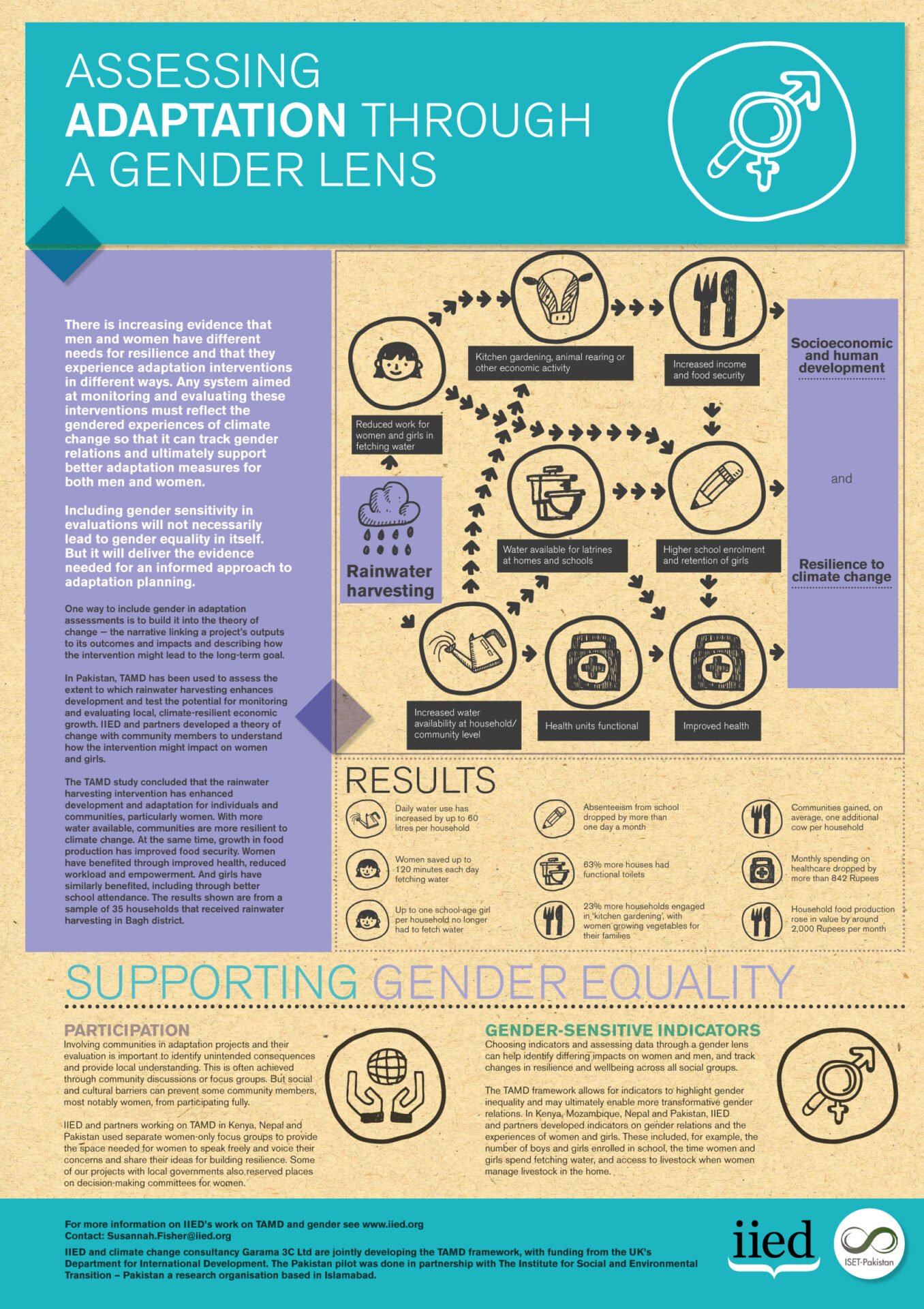Assessing Adaptation Through a Gender Lens


Click to enlarge.
The 9th International Conference on Community-Based Adaptation (CBA9) took place in Nairobi, Kenya, from April 24-30 2015. The CBA series of conferences focus on the latest developments in community-based adaptation to climate change. The theme of this year’s event was “Measuring and enhancing effective adaptation”, and all the posters presented at the conference were summaries of projects related to the conference theme. This poster is one of the posters featured at the conferance. For more information about CBA9, visit: www.cba9.org. If you want to learn more about community based adaptation, please visit the GICBA platform on weADAPT.
Introduction
There is increasing evidence that men and women have different needs for resilience and that they experience adaptation interventions in different ways. Any system aimed at monitoring and evaluating these interventions must reflect the gendered experiences of climate change so that it can track gender relations and ultimately support better adaptation measures for both men and women.
Including gender sensitivity in evaluations will not necessarily lead to gender equality in itself. But it will deliver the evidence needed for an informed approach to adaptation planning.
Tracking Adaptation and Measuring Development (TAMD)
One way to include gender in adaptation assessments is to build it into the theory of change — the narrative linking a project’s outputs to its outcomes and impacts and describing how the intervention might lead to the long-term goal.
In Pakistan, TAMD has been used to assess the extent to which rainwater harvesting enhances development and test the potential for monitoring and evaluating local, climate-resilient economic growth. IIED and partners developed a theory of change with community members to understand how the intervention might impact on women and girls.
The TAMD study concluded that the rainwater harvesting intervention has enhanced development and adaptation for individuals and communities, particularly women. With more water available, communities are more resilient to climate change. At the same time, growth in food production has improved food security. Women have benefited through improved health, reduced workload and empowerment. And girls have similarly benefited, including through better school attendance. The results shown are from a sample of 35 households that received rainwater harvesting in Bagh district.
Supporting Gender Equality
Participation
Involving communities in adaptation projects and their evaluation is important to identify unintended consequences and provide local understanding. This is often achieved through community discussions or focus groups. But social and cultural barriers can prevent some community members, most notably women, from participating fully.
IIED and partners working on TAMD in Kenya, Nepal and Pakistan used separate women-only focus groups to provide the space needed for women to speak freely and voice their concerns and share their ideas for building resilience. Some of our projects with local governments also reserved places on decision-making committees for women.
Gender Sensitive Indicators
Choosing indicators and assessing data through a gender lens can help identify differing impacts on women and men, and track changes in resilience and wellbeing across all social groups.
The TAMD framework allows for indicators to highlight gender inequality and may ultimately enable more transformative gender relations. In Kenya, Mozambique, Nepal and Pakistan, IIED and partners developed indicators on gender relations and the experiences of women and girls. These included, for example, the number of boys and girls enrolled in school, the time women and girls spend fetching water, and access to livestock when women manage livestock in the home.
Results
– Women saved up to 120 minutes each day fetching water.
– Daily water use has increased by up to 60 litres per household.
– Up to one school-age girl per household no longer had to fetch water.
– Absenteeism from school dropped by more than one day a month.
– 63% more houses had functional toilets.
– 23% more households engaged in ‘kitchen gardening’, with women growing vegetables for their families.
– Monthly spending on healthcare dropped by more than 842 Rupees.
– Communities gained, on average, one additional cow per household.
– Household food production rose in value by around 2,000 Rupees per month.
Contact:
This poster was designed and produced by Susannah Fisher at IIED.
(0) Comments
There is no content